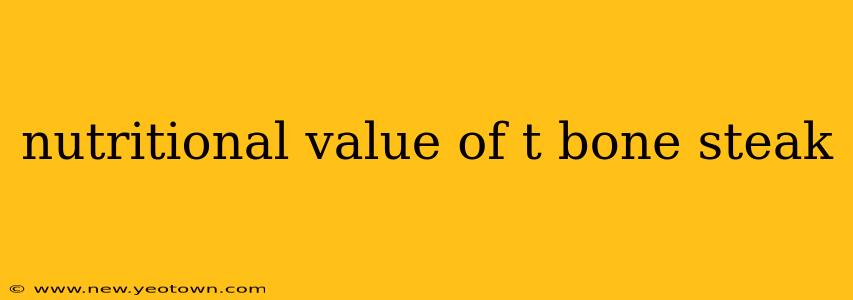The sizzle of a perfectly seared T-bone steak, the juicy tenderness… it's a culinary experience many crave. But beyond the deliciousness, lies a nutritional profile that deserves a closer look. This isn't just a decadent treat; it's a meal packed with essential nutrients that fuel your body. Let's delve into the world of T-bone steak nutrition, exploring its benefits and addressing some common questions.
What are the macronutrients in a T-bone steak?
A T-bone steak, roughly 3 ounces (85g) cooked, is a significant source of protein, boasting approximately 20-25 grams. This high-quality protein is crucial for building and repairing tissues, supporting immune function, and producing enzymes and hormones. It's also a respectable source of fat, largely saturated, contributing to its rich flavor and texture. The fat content varies depending on the cut and marbling, but generally falls within the 10-20 gram range. Carbohydrates are virtually absent in a plain T-bone steak.
What vitamins and minerals are in a T-bone steak?
Beyond the macronutrients, T-bone steak shines as a nutritional powerhouse, offering a substantial amount of essential vitamins and minerals. It's an excellent source of iron, crucial for red blood cell production and oxygen transport throughout the body. A single serving provides a significant portion of your daily iron needs, especially important for preventing anemia. It's also rich in zinc, vital for immune function and wound healing, and vitamin B12, essential for nerve function and DNA synthesis. Additionally, it contains smaller amounts of other B vitamins, selenium, and phosphorus.
Is a T-bone steak high in cholesterol?
This is a frequently asked question, and the answer is nuanced. Yes, T-bone steak, like other red meats, contains cholesterol. However, the impact of dietary cholesterol on blood cholesterol levels is less significant than previously believed. Current research focuses more on the impact of saturated fat, which is present in T-bone steak. Moderation is key. Enjoy your steak as part of a balanced diet and consult your doctor or registered dietitian if you have concerns about cholesterol.
How many calories are in a T-bone steak?
Calorie content varies significantly depending on the size and fat content of the steak. A 3-ounce (85g) serving generally falls within the 200-300 calorie range. However, larger portions or steaks with heavier marbling will naturally contain more calories. Being mindful of portion sizes is crucial for managing your overall caloric intake.
Are there any health risks associated with eating T-bone steak?
While T-bone steak offers numerous nutritional benefits, it's important to acknowledge potential health risks. High consumption of red meat has been linked to an increased risk of certain cancers and heart disease. The high saturated fat content is a contributing factor. As with any food, moderation is key. Incorporating T-bone steak into a balanced diet rich in fruits, vegetables, and whole grains helps mitigate these potential risks.
How can I prepare a T-bone steak healthily?
To maximize the nutritional value while minimizing potential drawbacks, opt for leaner cuts and trim away excess visible fat before cooking. Grilling, baking, or pan-searing are healthier alternatives to deep-frying. Avoid overcooking, as it can lead to nutrient loss and toughness. Seasoning with herbs and spices instead of heavy sauces adds flavor without extra calories or sodium.
The T-bone steak, with its rich flavor and impressive nutritional profile, can certainly be a part of a healthy and balanced diet. By understanding its nutritional content and practicing mindful consumption, you can enjoy this culinary delight while reaping its nutritional benefits. Remember to always consult with a healthcare professional or registered dietitian for personalized dietary advice.

